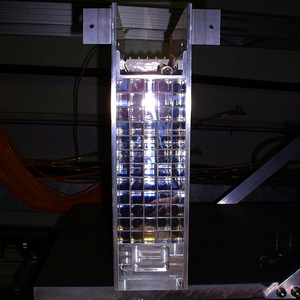Oct. 12, 2007 Research Highlight Physics / Astronomy
Looking forward at proton collisions
Asymmetry in neutrons produced by proton collisions makes a good detector for spin-polarized protons
 Figure 1: Photo of the calorimeter used to measure the asymmetry in neutron production of high-energy proton collisions.
Figure 1: Photo of the calorimeter used to measure the asymmetry in neutron production of high-energy proton collisions.
An international team of researchers at the Relativistic Heavy Ion Collider (RHIC) of Brookhaven National Laboratory, in the US, has developed a new particle detector and used it to observe a large asymmetry in the distribution of neutrons produced during the collision of protons.
At RHIC, high-energy collisions of protons are studied to understand the fundamental physics governing subatomic particles like protons and neutrons. In these collisions, energy is converted to matter that generates a large number of particles as a result.
Of particular interest to particle physicists is the role of the quantum-mechanical property known as ‘spin’ in these collisions. Just as the needle of a compass points in a certain direction, so does the spin of protons and neutrons. The researchers have now studied collisions where the spins of the protons in the two colliding beams of the RHIC point in the same direction.
As the direction of the spin polarization is predetermined, any asymmetries in the direction at which the generated particles are scattered provide valuable clues on the influence of spin. “Such results are not only important to understand the fundamental physics of the collisions, but also to eventually use [these] asymmetries as a monitor for RHIC beam polarization,” explains Yuji Goto from the RIKEN team.
In their study, published in Physics Letters B 1, the researchers have observed a large asymmetry in the number of neutrons that are produced in the left compared with the right side of the polarized proton beams. Their detector (Fig. 1), which is relatively compact for such complex tasks, consists of a calorimeter that measures the energy that is deposited in one of the beam directions. It also contains position and timing sensors for the necessary detailed analysis.
The asymmetry was found to be surprisingly large and Goto is convinced that “this is one of the most important results so far in the collision of spin-polarized protons at the RHIC”. Already, these findings provide important clues towards the fundamental processes leading to this asymmetry.
Moreover, the large asymmetry in neutron production can be used as a sensitive tool to measure the spin polarization and direction in the original proton beam. Indeed, the calorimeter has already been implemented at RHIC as a monitor of the polarization of the proton beams. The fundamental importance of these results aside, the detector developed by the researchers will play an important role in the other fundamental investigations performed at RHIC.
References
- 1. Fukao, Y., Togawa, M., Bazilevsky, A., Bland, L. C., Bogdanov, A., Bunce, G., Deshpande, A., En’yo, H., Fox, B.D. & Goto, Y. et al. Single transverse-spin asymmetry in very forward and very backward neutral particle production for polarized proton collisions at sqrt{s} =200 GeV. Physics Letters B 650, 325–330 (2007). doi: 10.1016/j.physletb.2007.05.049
